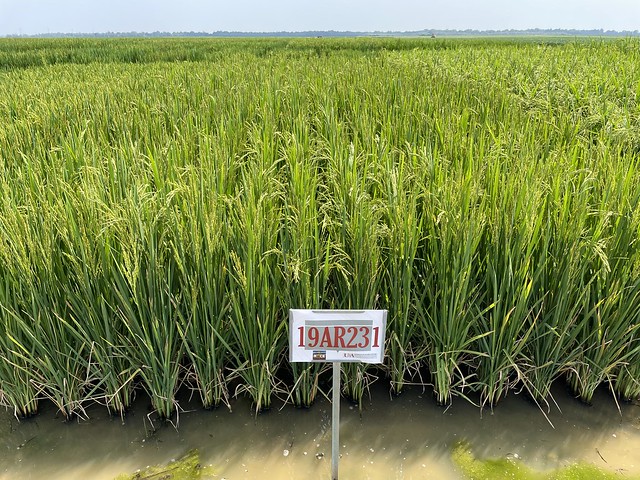April 15, 2022
New jasmine-type aromatic rice line released by Arkansas Rice Breeding Program as demand heats up
By John Lovett
U of A System Division of Agriculture
Fast facts
- ARoma 22 is third jasmine-type aromatic rice from the Arkansas Rice Breeding Program
- Jasmine-type rice from Thailand has driven Asian rice imports to U.S.
(552 words)
Related PHOTOS: https://flic.kr/s/aHBqjzKLU6
FAYETTEVILLE, Ark. — A new jasmine-type aromatic rice called ARoma 22 has been released by the Arkansas Agricultural Experiment Station amid rising U.S. demand for aromatic rice.

ARoma 22 offers increased aromatics and color consistency over its predecessor, and equals several qualities looked for by consumers of imported Asian aromatic rice, sensory tests show.
According to the U.S. Department of Agriculture’s Economic Research Service, a sharp increase in imported rice over the past few years from Asia has been driven by jasmine-type rice from Thailand.
“Considering the high competition from Asian and South American suppliers and the stagnant export prospects for U.S. long-grain rice, aromatic rice represents an opportunity for U.S. farmers to expand production and lower the dependency on aromatic rice imports,” said Alvaro Durand-Morat, assistant professor of agricultural economics and agribusiness for the experiment station, the research arm of the University of Arkansas System Division of Agriculture.
The experiment station’s Rice Breeding Program added the aromatic breeding program in 2010 to fill a growing niche market. The Division of Agriculture’s Foundation Seed Program has seen aromatic rice orders double over the past few years. In 2020, the program sold 1,249 bags of seed. For the 2023 growing season, growers have pre-ordered 2,565 bags. A bag contains 50 pounds of rice seed.
ARoma 22 was developed by emeritus professor Karen Moldenhauer and Debra Ahrent Wisdom of the Arkansas Rice Breeding Program based at the Division’s Rice Research and Extension Center in Stuttgart.
“The goal is to meet the consumer and grower demands of developing high-quality, high-yielding aromatic rice lines,” Wisdom said. “The growers who have produced aromatic rice would like to have more seed to grow as they are finding more markets available.”
Wisdom has been an assistant breeder specializing in jasmine-type aromatic rice since 2010. She is also the accounts manager for the Foundation Seed Program, which sells the rice and soybean seed developed and released by the Division of Agriculture.
Wisdom noted that the consumers who have tried ARoma 22 are “very happy with the flavor and quality of the rice.”
Sensory tests conducted in February at the experiment station’s Sensory Science Center found ARoma 22 to compare favorably to other jasmine-type varieties.
After consulting with the Arkansas Rice Research and Promotion Board, the variety was submitted for restricted public release, where purchasers of foundation seed sign a non-exclusive, non-royalty bearing license agreement before purchasing seed.

ARoma 22 averaged 167 bushels per acre with high milling yields in five Arkansas Rice Variety Advancement Trials. ARoma 22 reaches 50 percent heading at 88 days with “excellent” straw strength, according to data collected from the Arkansas Uniform Rice Regional Nursery and reported in 2020 research trials. It is moderately susceptible to blast, sheath blight, bacterial panicle blight, and susceptible to false smut.
Arkansas continues to be ranked first in the nation in rice production. More than 1.4 million acres are harvested annually in over 40 counties, according to the 2021 Arkansas Agriculture Profile (https://bit.ly/2021ArkAgProfile). Commodity production and value in 2020 for Arkansas rice was nearly $1.3 billion.
A total of 16 rice varieties have been developed by the Rice Breeding Team and released to Arkansas rice growers during the past 10 years. Three of those have been aromatic lines to meet a growing niche market, Wisdom said.
To learn more about Division of Agriculture research, visit the Arkansas Agricultural Experiment Station website: https://aaes.uada.edu/. Follow us on Twitter at @ArkAgResearch. To learn more about the Division of Agriculture, visit https://uada.edu/. Follow us on Twitter at @AgInArk.
About the Division of Agriculture
The University of Arkansas System Division of Agriculture’s mission is to strengthen agriculture, communities, and families by connecting trusted research to the adoption of best practices. Through the Agricultural Experiment Station and the Cooperative Extension Service, the Division of Agriculture conducts research and extension work within the nation’s historic land grant education system.
The Division of Agriculture is one of 20 entities within the University of Arkansas System. It has offices in all 75 counties in Arkansas and faculty on five system campuses.
Pursuant to 7 CFR § 15.3, the University of Arkansas System Division of Agriculture offers all its Extension and Research programs and services (including employment) without regard to race, color, sex, national origin, religion, age, disability, marital or veteran status, genetic information, sexual preference, pregnancy or any other legally protected status, and is an equal opportunity institution.
# # #
Media Contact: John Lovett
U of A System Division of Agriculture
Arkansas Agricultural Experiment Station
(479) 763-5929
jlovett@uada.edu